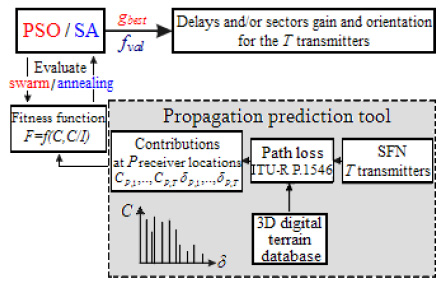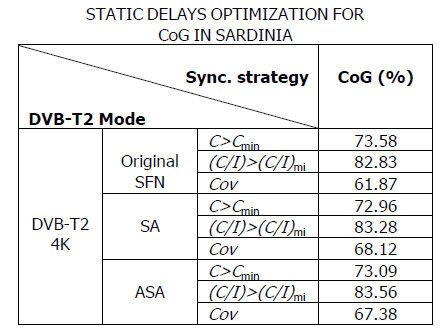Matteo Anedda - Heuristic Optimization for DVB-T/H SFN Coverage Using Simulated Annealing
Ultimo aggiornamento Giovedì 23 Ottobre 2014 18:16 Scritto da Matteo Anedda Martedì 30 Aprile 2013 13:11
Architettura e Ingegneria - Tesi di Laurea
The digital broadcasting systems, DAB - Digital Audio Broadcasting, DRM - Digital Radio Mondiale, DVB terrestrial DVB-T and more recently DVB-T2 based on COFDM modulation, commonly exploit the single-frequency network (SFN) technique. In such networks, the treatment of inter-symbol interference and the synchronization strategy receiver side is a crucial aspect in network planning and to achieve the desired coverage defined in term of QoS within a certain area of interest. In this work a propagation prediction tool, the Simulated Annealing (SA) and the Advanced SA (ASA) are considered.
The propagation prediction tool allows to estimate and optimize the transmission parameters based on 3D digital map terrain and path loss based on ITU-R P.1546. The treatment of inter-symbol interference and the static delays to improve synchronization of the signals that arrive within the area of interest is also considered. In particular, SA is employed to optimize the coverage of the 8K and 4K mode with a Guard Interval (GI) of 1/4 of the duration of the OFDM symbol. SA optimizes the output of the propagation prediction tool, which is a N-dimensional vector where N is the number of variables influenced by static delay for each transmitter.
In this work we introduce a high density of transmitters based on a real SFN, thus a greater computational complexity due both increase data matrices dimension and self-interference problems involved in the best static delay configuration. More restrictive threshold values are employed in DVB-T2 than DVB-T network. The effect of antenna diagrams both transmitters side and receivers mobile side is also considered.
The obtained results make it possible to evaluate the efficiency of Simulated Annealing in a coverage optimization problem of DVB-T/T2/H. An efficient set-up which allows to find where the global minimum of the objective function is located. A good compromise between several parameters, speed and accuracy convergence of the solution is achieved.
According to the COFDM properties the signals arriving with a time difference lower than the guard interval will contribute constructively to the C/I total, while the signals which arrive outside the guard interval are treated as interference.
 (1)
(1)
In equation (1), Pi denotes the power received from the i-th transmitter, wi is the receiver mask weighting value of i-th echo, δi the i-th echo delay relative to the synchronization reference δ0.

Equation (1) is the mathematical model which defines the relationship with the C/I for COFDM receiver. In this mathematical expression, the set of transmitters is represented by Ω={1,......,N}. The transmitters of other SFN networks, which transmit at the same frequency, are represented by Ψ={1,......,M} and N0 is the noise power at the receiver. One of the main objectives in the optimization process is the identification of the network parameter(s) that should be optimized. In addition, the algorithm to be used should be identified and the so-called fitness function (2) should be described. The variable δ0 is one of possible optimization parameter. It influences the probability of total coverage because the increase or decrease of the relationship C/I depends on it.
The fitness function is defined as follows:
 (2)
(2)
where the level of the minimum field required Cmin and the relation (C/I)min are the reference values. Therefore, the optimization process must minimize the fitness function with the aim of achieving the highest percentage of coverage. The fitness function is represented by the ratio between receiver locations without coverage and the total amount of P receiver locations. Coverage is defined when the total power C of the useful signals and the C/I ratio given by (1) concurrently are above the threshold values considered for the service, C>Cmin and C/I>(C/I)min respectively.
![Fig. 2. Optimized SFN Sardinia network: gain sectors and relative orientation. The white, blue and red sectors represent the gains in the ranges [-0.99, 0], [-2.99, -1] and [-5, -3] dB, respectively. Fig. 2. Optimized SFN Sardinia network: gain sectors and relative orientation. The white, blue and red sectors represent the gains in the ranges [-0.99, 0], [-2.99, -1] and [-5, -3] dB, respectively.](/pubbliscienze/images/stories/4-matteo-anedda.jpg)
The aim of this work is coverage optimization area exploiting heuristic algorithms. The term heuristic is used for algorithms that find solutions among all possible ones, find it fast and easily. They do not guarantee find best solution and for this reason they may be considered as approximately and not accurate algorithms. However, the heuristic approach is a common problem-solving in the simulation for several possible reasons: solving problem may just be impossible, and solving problem may just be too costly in terms of time or processing power. The use of heuristic algorithms and a propagation prediction tool allows estimating and increasing the power received at each location according to the ITU–R recommendation P.1546. The complete approach is shown in Fig. 1, in which two independent blocks work together. Let us consider a SFN consisting of T transmitters distributed over a certain region for which the 3D digital terrain maps are known. The optimization method proposed shows different blocks which interact in order to obtain the optimum configuration for the transmitters of the SFN network. For the network infrastructure, the prediction of the propagation is used to estimate the contribution in terms of power, Ci and delays δi for all the transmitters and receivers. In order to evaluate the optimization algorithm the ITU-R P.1546 propagation prediction loss has been used in this study.
SA has been tested with different OFDM modes: DVB-T 8K (useful symbol Tu=896 μs and 1/4 guard interval (GI) Δ=224 μs) and DVB-T2 4K (useful symbol Tu=2220 μs and 1/4 GI Δ=555 μs). Coverage indicates the percentage of receiver locations in which either the C>Cmin or C/I>(C/I)min criteria, or both, Cov, are accomplished.
We consider a SFN for DVB-T2, 4K mode involving mobile reception and optimizing the coverage by efficiency of the SA. This region of interest is around 260 km long and 120 km wide in expanse. The number of receiver locations is equal to P =3.129x106. SFN Sardinia island (Italy) network given in Fig. 2 consists of 78 transmitters. Broadcast band and frequency used are VHF band III, channel E9 - 205.5 MHz.
The power range associated to main transmitters starts from 1W up to 2kW. Power transmitted for all sites is equal to 1kW EIRP. Modulation used is 16 QAM code rate 1/2 guard time 1/4 and bandwidth 1.7MHz. Scattered pilot pattern is equal to PP1. Receivers side a mobile reception at no less than 1.5 m above ground level while moving is considered.
C/Imin=10.2 dB is considered in this study case. Cmin = Pmin = -95.9 dBm + C/N [dB] is equal to -85,7 dBm, the minimum receiver signal field strength considered in the simulations. The centre of gravity (CoG) approach well responds to pre-echoes and delayed signals of similar amplitude A planning tool combines the heuristics, SA, ASA and a propagation prediction tool is proposed with the final objective of optimizing SFN network coverage by reducing self-interfered areas in Sardinia island.
The coverage is improved by minimizing the areas suffering self-interference. The study has demonstrated the effecacy of heuristic algorithms in cover optimization. Sectorization of antennas and synchronization strategies are also effectively considered.
The SA has improved the DVB-T/T2 service of an existing network without changing the physical location of the transmitters. The method can be used in the design phase in order to find the best location of the transmitters or in the event of existing networks expansion. SA responds well to different configurations of hilly terrain and high density of transmitters; results obtained shown effects of amendments.
The strategy is validated by means of simulation, showing good performance in front of manual iterative adjustments involving static delays, gain and orientation of antennas.
Any amendments via software require low economic resources. These amendments can be made independently by each broadcaster, each SFN network operates at a certain frequency and can have its own static mapping of delays. All this is possible by identifying the best set of parameters of SA. The search for a good compromise between speed of convergence and goodness of the solution is proposed in this paper. The efficacy of SA and ASA to optimize a complex system of network planning is verified in this work.

Elementi di innovazione introdotti dallo studio. Questa tesi presenta un nuovo approccio per quanto concerne l’ottimizzazione della copertura del segnale digitale terrestre DVB-T/T2 su reti SFN per ricevitori fissi e mobili, mediante l’impiego di algoritmi euristici. Il lavoro presenta considerevoli vantaggi di tipo tecnico, sociale ed economico. I benefici tecnici permettono di semplificare le modifiche e future espansioni della rete, i benefici sociali permettono all’utente di usufruire di un servizio di migliore qualità mentre i benefici economici permettono di fornire un servizio più veloce e ad un prezzo competitivo in un settore aggressivo come quello delle telecomunicazioni..
Matteo Anedda
Tesi di Laurea Specialistica
Autore: Matteo Anedda
Relatore: Maurizio Murroni, email:
Questo indirizzo e-mail è protetto dallo spam bot. Abilita Javascript per vederlo.
, tel.: +390706755907![]() +390706755907
+390706755907
Presidente della Commissione: Daniele Giusto
Università: Università degli Studi di Cagliari
Facoltà: Facoltà di Ingegneria
Corso: Laurea Magistrale in Ingeneria delle Telecomunicazioni
Data di Discussione: 20/07/2012
Voto: 110 cum laude
Disciplina: Telecomunicazioni
Tipo di Tesi: Sperimentale
Anno di Iscrizione: 2010/11
Altri Autori:
Altri Relatori: Prof. Pablo Angueira Buceta
Lingua: Inglese
Grande Area: Area Scientifica
Dignità di Stampa: Non definito
In Collaborazione con: La Tesi è stata svolta presso l’Università dei Paesi Baschi (EHU/UPV) di Bilbao
Settori Interessati: Operatori di televisione digitale terrestre DVB-T/T2 per dispositivi di ricezione fissa e mobile
Pubblicata in: www.pubblitesi.it
